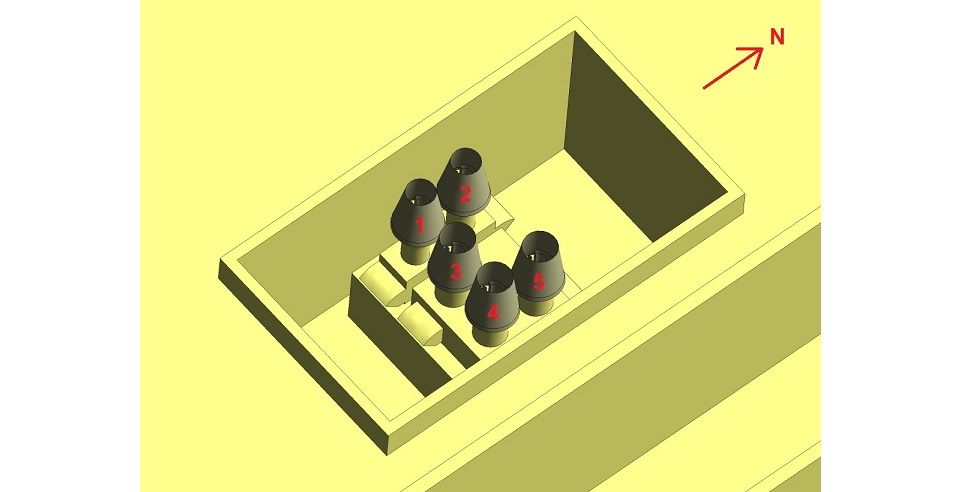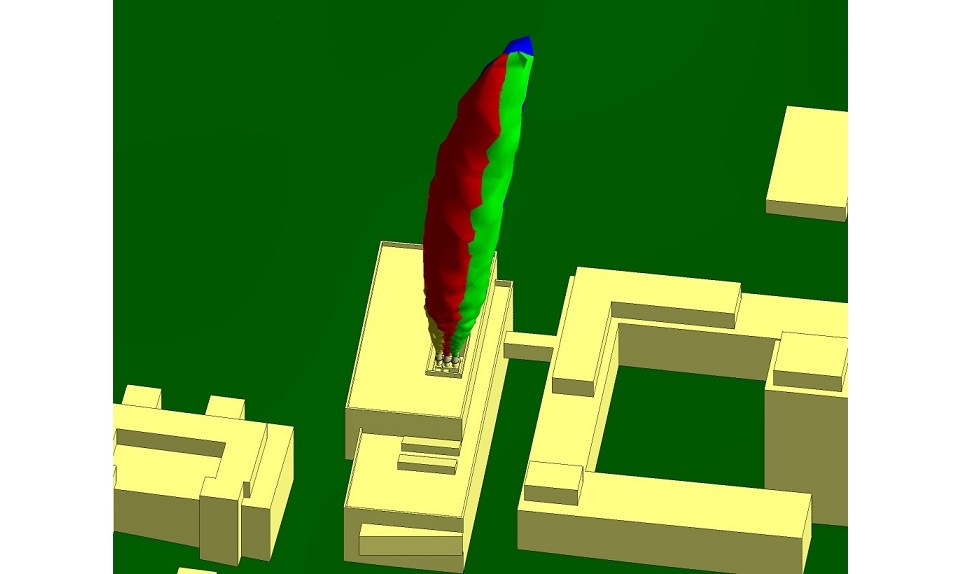Case Study – Fume Dispersion from a University Teaching Laboratory
The challenge
The University of Birmingham is building a new teaching laboratory on its Edgbaston
Campus. The laboratory will contain fume cupboards that will discharge fumes into
the atmosphere from strobic flues on the roof. The fumes must disperse safely into
the atmosphere and not pose a safety hazard to the occupants of other buildings or
pedestrians, whatever the wind conditions.
Teaching laboratory seen from the southeast

The solution
When a wind blows onto a building it will separate from the sides and roof of the
building and generate complex recirculating flows and turbulence. The flues can be
made tall so that the fumes enter the relatively undisturbed air several metres
above the building. The trajectory and dispersion of the fumes can then be
determined with reasonable accuracy using simple analytical models. However, the
planning authorities may reject this solution if they feel the flues interfere
with the harmony of the building. Consequently, designers tend to specify flues
that cannot be seen above the roof line of the building when viewed from the
ground. When this is the case, the complexity of the flow around the flues makes
the task of computing the dispersion of the fumes much more difficult and beyond
the capabilities of simple analytical models.
Computational fluid dynamics (CFD) provides an alternative modelling approach.
Although CFD software is more expensive to use than a simple analytical model, it
provides much more realism because it does not rely on empirical data but solves
the basic equations of fluid flow along with a model for turbulence.
Atkinson Science used state-of-the-art CFD software to create a CFD model of the
teaching laboratory, the flues, the surrounding buildings and the undulating
landscape of the campus. The profile of flow speed from the strobic flues is far
from uniform. To replicate this profile, we created a separate detailed model of a
flue and imported several copies of it into the main CFD model at the appropriate
locations on the roof. The creation of the strobic flue model is described in a
separate case study.
Strobic flues

The concentrations of fumes that are generated in the fume cupboards must be below
the long-term exposure limit for the safety of the students. Consequently, under
normal circumstances the concentrations leaving the flues will be below the
long-term exposure limit and will not pose a hazard. However, if there is an
accidental spill of a volatile substance, then there may be a temporary increase
in concentration of one or even two orders of magnitude (10 times or 100 times)
and the fumes must be diluted up to 100 times by the atmosphere before they reach
another building or the ground. There are no regulations on the number of
dilutions a flue system must provide, but given our experience, we would expect a
well-designed flue system to provide 100 dilutions, whatever the wind conditions.
We used Met Office data to determine the wind conditions that are likely to occur
over the Edgbaston Campus. Then we used the CFD model to calculate the dispersion
of the fumes for a low wind speed and a high wind speed with the wind direction
every 45° from north. After reviewing these initial computations we used the
CFD model see if we could find any wind conditions that would push the number of
dilutions below 100.
CFD is a science that produces arresting graphical images. These images can often
explain a complex phenomenon that might be difficult to explain in words. In
dispersion studies we can create an iso-surface representing a fixed number of
dilutions (say 100) and display a different coloured iso-surface for each flue.
Then we can see immediately if a flue is underperforming at a particular wind
condition because the iso-surface for the flue intersects another building or the
ground. Images of iso-surfaces representing 100 dilutions are shown below.
Iso-surfaces representing 100 dilutions for a westerly
wind at 0.25 m s−1

Iso-surfaces representing 100 dilutions for a westerly wind at
10 m s−1

We found that some wind conditions produced complex wind flows that caused the
iso-surfaces to be twisted and distorted. However, we could not find a wind
condition at which iso-surfaces for 100 dilutions came into contact with another
building or the ground. Consequently, we were able to conclude the study by
approving the flue design.
The benefits
The University safety officer could be reassured that the system of strobic flues
proposed for the new teaching laboratory would perform satisfactorily, whatever
the wind conditions.